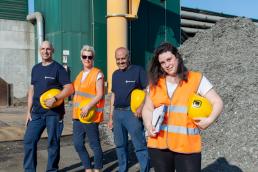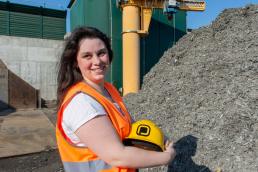Environmental certification: a competitive advantage for waste recovery and treatment companies?
Since July 2015, the transition of the Panizzolo waste treatment plant to the Integrated Environmental Authorization (A.I.A.) has added an important element to the business development plan. With the expansion of treated waste and the investment in new designs, the company can now boast an End-of-Waste treatment cycle with its own patented hammer mills.

Good morning Beatrice. Can you explain your role and how you operate in relation to the Integrated Environmental Authorization?
Taking on the role of Head of security and corporate certifications, I took over from Piove di Sacco in conjunction with the application process for AIA authorization. It is not immediate to understand how an authorization mechanism works and, consequently, to manage the whole certification process. Each company is different but it has been a very stimulating and challenging experience.
Together with the consultant we studied the activity on several fronts, both from an environmental and production point of view, thus conforming many macro areas with respect to the directives. In particular, we have more defined the role of the staff, whether working in the office or on the construction site. With this in mind, we have all participated in many training days, an activity that we are still pursuing both to create awareness and to confirm our preparation. In carrying out my work, the most important thing is to involve all the operators concerned with adequate training, information and indicating an operational direction.
What pluses does ISO 14001 allow us to obtain?
The ISO 14001 certification procedure ran parallel to the A.I.A., which actually entered into force in 2016. We took this path because it provided us with many benefits and a professional working methodology for achieving the A.I.A. objectives. Alongside the more traditional controls, new registers have been added for monitoring the consumption of raw materials such as oil, diesel, electricity and more. In doing so, we gained greater awareness of how ecological and economic costs impact on each waste treated.
On the other side, our customers are sure to buy a metal treated with certain quality standards. Increasingly suppliers and customers, especially foreign ones, prefer to relate to companies holding these certifications. A number that will surely increase in the coming years, given that companies also gain greater authority before the state control bodies.
The certifications are regulated, therefore they must be confirmed annually and are subject to updates. In fact, with the maintenance visit in April 2020 we moved to ISO 14001: 2015 certification. This year with the COVID-19 emergency was doubly demanding, having to do everything remotely.
Can you better explain the company’s environmental policy?
ITogether with the ISO 14001 certification, the company has formalized this internal document, where we become aware that our business has an impact on the territory and, consequently, we formalize a series of future programs for work improvement. Also for this reason Panizzolo has invested in the refining plant for metal waste.

Unlike the blade turbines or cell turbines on the market, our patented refining mills achieve an output with a degree of purity that is difficult to compare in the sector. A plus that allowed to integrate the European certifications 333-2011 and 715-2013, attesting the production of secondary raw material.
But what does it mean to be certified as producers of raw materials?
Virtually certification works this way. During the treatment cycle the material must be checked and comply with certain standards, including a percentage of purity defined by the European guidelines. Specific internal reports are compiled periodically and meticulous checks are performed on the granule of secondary raw material obtained. When the raw material is transferred to the customer it is always accompanied by our declaration of conformity, indicating the respective European code.
When the company produces second raw materials, it increases the economic value of metals and in doing so, it also obtains greater administrative simplicity. The output is no longer managed as waste, therefore the complicated procedures of the unloading form are replaced with a simple delivery document. Obviously all this could not be done if upstream there was no ISO certification attesting the quality of treatment of the metal waste.
Many customers visit the treatment plant when they have to evaluate the purchase of Panizzolo Recycling Systems products?
Yes it happens many times. Besides being important to see our production line in operation, I have often seen a lot of interest in the quality of the outputs. They often ask me to see the second raw material certificate. Honestly, it is a lot of fun to see their amazement in comparing the granulated copper in output compared to the input waste. However, in general, companies want to visit us to confirm our professionalism, knowing that we are one of the very few companies that is both a manufacturer and a user.
How do you see the future of certifications? And what will be the next steps of Panizzolo Recycling Systems?
I think that in the coming years we will see an increase in the number of certified companies. All our customers and suppliers are, even the smallest ones. The European Union is also an additional factor pushing more towards end-of-waste treatment cycles and the reintroduction of the second raw material into the economic cycle. In Panizzolo Recycling Systems for the near future we are considering to implement the certifications of the Arzergrande headquarters. We are currently in the analysis phase, but we will soon identify the most relevant typology.